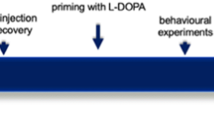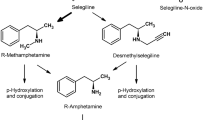Summary
The “cheese effect”, potentiation of sympathomimetic action of indirectly acting amines such as tyramine, the main side effect of irreversible nonselective and selective monoamine oxidase (MAO) A inhibitors, has largely been eliminated in the new generation of reversible selective MAO-A and B and irreversible MAO-B inhibitors. These selective inhibitors are demonstrating unique pharmacology and initial controlled clinical studies are providing evidence to support their action as anti-depressants and anti-Parkinson's disease drugs and possibly as neuroprotectors. Thirty years of experience with nonselective MAO inhibitors has resulted in a better understanding and management of the new generation of MAO inhibitors. Because of their selective action on the specific forms of MAO, which results in selective elevation of brain noradrenaline and serotonin on the one hand and dopamine and phenylethylamine on the other, it is hoped that these drugs will be able to elucidate the functional roles of MAO-A and B subtypes with regards to dopamine metabolism in the human brain.
Similar content being viewed by others
References
Bevan Jones AB, Pare CMB, et al (1972) Brain amine concentrations after monoamine oxidase inhibitor administration. Br Med J 1: 17–19
Birkmayer W, Riederer P, Ambrozi L, et al (1977) Implications of combined treatment with Madopar and 1-deprenyl in Parkinson's disease. Lancet i: 439–444
Birkmayer W, Riederer P, Youdim MBH, Linauer W (1975) The potentiation of the antiakinetic effect after L-dopa treatment by an inhibitor of MAO-B, deprenil. J Neural Transm 36: 303–326
Birkmayer W, Riederer P, Youdim MBH (1982) (−)-Deprenyl in the treatment of Parkinson's disease. Clin Neuropharmacol 5: 195–230
Bowen DM, Francis PT, Palmer AM (1985) Cholinergic and non-cholinergic neurotransmitters hypothesis for Alzheimer's disease. In: Fisher A, et al (eds) Alzheimer's and Parkinson's diseases. Plenum, New York, p 53
Butcher SP, Fairbrother IS, Kelly JS, Arbuthnott GW (1990) Effects of selective monoamine oxidase inhibitors on the in vivo release and metabolism of dopamine in rat striatum. J Neurochem 55: 981–988
Chan-Palay V (1990) Depression and senile dementia of the Alzheimer type: catecholamine changes in the locus coeruleus — basis for therapy. Dementia 1: 253
Collins CGS, Sandler M, Williams ED, Youdim MBH (1970) Multiple forms of human brain mitochondrial monoamine oxidase. Nature 225: 817–820
Da Prada M, Kettler R, Cesura AM, Richards JG (1988) Reversible enzyme-activated monoamine oxidase inhibitors: new advances. Pharmacol Res Commun 20: 21–33
Da Prada M, Kettler R, Burkard WP, et al (1990) Some basic aspects of reversible inhibitors of monoamine oxidase-A. Acta Psychiatr Scand 82: 7–12
Da Prada M, Kettler R, Cesura R, Richards AM, Dingemanse J (1991) Enzyme activated reversible and highly selective MAO-B inhibition by RO 19-6327 preclinical and clinical findings. Eur Neuropsychopharmacol 1: 521–523
Datatop (1989) Selegiline and Parkinson's disease. N Engl J Med 321: 1364–1371
Donnelly CH, Murphy DL (1974) Monoamine oxidase in man. Enzyme characteristics in platelets, plasma and other tissues. Adv Biochem Psychopharmacol 12: 71–86
Dostert P (1988) The effect of milacemide on rat brain dopamine metabolism. Pharmacol Res Commun 20: 94–98
Finberg JPM, Tenne M (1982) Relationship between tyramine potentiation and selective inhibition of monoamine oxidase types A and B in the rat vas deferens. Br J Pharmacol 77: 13–21
Finberg JPM, Youdim MBH (1985) Modification of blood pressure and nictitating membrane response to sympathetic amines by selective monoamine oxidase inhibitors type A and type B. Br J Pharmacol 85: 541–546
Finberg JMP, Youdim MBH (1988) Potentiation of tyramine responses in conscious rats by reversible inhibitors of MAO-A. J Neural Transm [Suppl 26]: 11–16
Finberg JPM, Tenne M, Youdim MBH (1981) Tyramine antagonistic properties of AGN 1135, an irreversible inhibitor of monoamine type B. Br J Pharmacol 73: 55–64
Garrick NA, Murphy DL (1980) Species differences in the deamination of dopamine and other substrates for monoamine oxidase in brain. Psychopharmacology 72: 27–33
Garrick NA, Scheinn M, Chang WH, Linnoila M, Murphy DL (1984) Differential effects of clorgyline on catecholamine and indole amine metabolites in the cerebral spinal fluid or rhesus monkey. Biochem Pharmacol 33: 1423–1427
Green AR, Youdim MBH (1975) Effect of monoamine oxidase inhibition by clorgyline, deprenyl and tranylcypromine on 5-hydroxytryptamine concentrations in rat brain and hyperactivity following subsequent tryptophan administration. Br J Pharmacol 555: 415–422
Green AR, Michel BD, Tordoff FC, Youdim MBH (1977) The evidence for dopamine deamination by both type A and type B monoamine oxidase in rat brain in vivo and for degree of inhibition of enzyme necessary for increased functional activity of dopamine and serotonin. Br J Pharmacol 60: 343–349
Haefely WE, Kettler R, Keller HH, Da Prada M (1990) RO-19-6327, a reversible and highly selective monoamine oxidase B inhibitor. A novel tool to explore the MAO-B function in humans. Adv Neurol 53: 505–512
Johnston JP (1968) Some observations upon a new inhibitor of monoamine oxidase in brain tissue. Biochem Pharmacol 17: 1285–1297
Konradi C, Svoma E, Jellinger K, Riederer P, Denney R, Thibault J (1988) Topographic immunocytochemical mapping of monoamine exidase-A, monoamine oxidase-B and tyrosine hydroxylase in human post mortem brain stem. Neuroscience 26: 791–802
Levitt P, Pintar J, Breakefield XO (1982) Immunological demonstration of monoamine oxidase B in brain astrocytes and serotonergic neurons. Proc Natl Acad Sci USA 20: 6385–6389
Liccione J, Azzaro AZ (1988) Different roles of type A and type B monoamine oxidase in regulating synaptic dopamine at D-1 and D-2 receptors associated with cyclic-AMP formation. Arch Pharmacol 337: 151–158
Melamed E (1988) Role of the nigrostriatal dopaminergic neurons in mediating the effect of exogenous L-dopa in Parkinson's disease. Mt Sinai J Med 55: 35–42
Möller HJ, Wendt G, Waldmeier P (1991) Brofaromine — a selective, reversible and short acting MAO-A inhibitor: review of the pharmacological and clinical findings. Pharmacopsychiatry 24: 50–54
Neff NH, Yang HYT (1974) The use of selective monoamine oxidase inhibitor drugs to modify amine metabolism in brain. Adv Biochem Psychopharmacol 12: 49–57
O'Carroll AM, Fowler CJ, Phillips JP, Tobia I, Tipton KF (1983) The deamination of dopamine by human brain monoamine oxidase. Arch Pharmacol 322: 198–222
Palfreyman MG, McDonald IA, Zreika M, Dudley M, Bey P (1991) Potent and selective irreversible inhibition of MAO-B by MDL 72,794 A. Eur Neuropsychopharmacol: 319–321
Pare CMB (1982) The present state of monoamine oxidase inhibitors? Lancet ii: 183
Reynolds GP, Riederer P, Sandler M, Jellinger K, et al (1978) Amphetamine and 2-phenylethylamine in post-mortem parkinsonian brains after (−)-deprenyl administration. J Neural Transm 43: 271–277
Richard JG, Marti SJ, Cesura AM, Da Prada M (1988) Autoradiographic distribution of (3H)-RO 19-6327 binding sites in rat CNS and peripheral organs in vitro and in vivo. Localization of MAO-B. Pharmacol Res Commun 20: 91–98
Riederer P, Youdim MBH (1986) Brain monoamine oxidase activity and monoamine metabolism in parkinsonian patients treated with 1-deprenyl. J Neurochem 46: 1349–1356
Riederer P, Youdim MBH, Rausch WD, Birkmayer W, et al (1978) On the mode of action of 1-deprenyl in the human central nervous system. J Neural Transm 43: 217–226
Riederer P, Konradi C, Schay V, Kienzl E, et al (1987) Location of MAO-A and MAO-B in human brain. A step in understanding the therapeutic action of 1-deprenyl. Adv Neurol 45: 111–119
Schoepp DD, Azzaro AZ (1982) The roles of type A and type B monoamine oxidase in the metabolism of released [3 H]-dopamine from rat striatal slices. Biochem Pharmacol 31: 2961–2968
de Varebeke PJ, Pauwels G, Buyse C, David-Remacle M, Mey J, Roba J, Youdim MBH (1989) The novel neuropsychotropic agent milacemide is a specific enzyme activated inhibitor of brain monoamine oxidase B. J Neurochem 53: 1109–1116
de Varebeke PJ, Schallauer E, Rausch WD, Riederer P, Youdim MBH (1990) Milacemide, the selective substrate and enzyme activated specific inhibitor of monoamine oxidase B increases dopamine but not serotonin in caudate nucleus of Rhesus monkey. Neurochem Int 17: 325–329
Waldmeier PC, Delini-Stula A, Maitre L (1976) Preferential deamination of dopamine by type A monoamine oxidase in rat brain. Arch Pharmacol 292: 9–14
Westlund K, Denney R, Kochersperger L, et al (1985) Distinct monoamine oxidase A and B population in primate brain. Science 230: 181–183
Wolf WP, Kuhn D, Youdim MBH (1985) Does brain 5-HIAA indicate serotonin release or monoamine oxidase activity? Eur J Pharmacol 109: 381–387
Youdim MBH (1983) In vivo noradrenaline is a substrate for brain monoamine oxidase A and B. Br J Pharmacol 477–480
Youdim MBH (1990) Inhibitors of dopamine inactivating systems as anti-Parkinson drugs. Adv Neurol 53: 483–488
Youdim MBH (1991) Aliphatic and aromatic amino acetamides novel substrates and specific reversible inhibitors of monoamine oxidase B. Eur Neuropsychopharmacol 1: 313–315
Youdim MBH, Finberg JPM (1991) New directions in monoamine oxidase A and B selective inhibitors and substrates. Biochem Pharmacol 41: 155–162
Youdim MBH, Collins GGS, Sandler M (1971) Monoamine oxidase: multiple forms and selective inhibition. Biochem J 121: 34–35 P
Youdim MBH, Collins GGS, Sandler M, et al (1972) Human brain monoamine oxidase. Multiple forms and selective inhibitors. Nature 236: 225–228
Youdim MBH, Banerjee DK, Pollard HB (1984) Isolated chromaffin cells from adrenal medulla contain promarily monoamine oxidase B. Science 224: 619–621
Youdim MBH, Da Prada M, Amrein R (eds) (1988) The cheese effect and new reversible MAO-A inhibitors. J Neural Transm [Suppl 26]: 1–124
Youdim MBH, Finberg JPM, Tipton KF (1988) Monoamine oxidase. In: Trendelburg U et al (eds) Catecholamines II. Springer, Berlin Heidelberg New York Tokyo, pp 125–197 (Handbook Exp Pharmacol, vol 90)
Zimmer R (1990) Relation between tyramine potentiation and monoamine oxidase (MAO) inhibition: comparison between moclobemide and other MAO inhibitors. Acta Psychiatr Scand [Suppl 360]: 81–83
Zürcher G, Keller HH, Kettler R, Borgulya J, Bonetti EP, Eigenmann R, Da Prada M (1990) RO-40-7592, a novel very potent and orally active inhibitor of catechol-O-methyl transferase. A pharmacological study in rats. Adv Neurol 53: 497–503
Author information
Authors and Affiliations
Rights and permissions
About this article
Cite this article
Youdim, M.B.H., Riederer, P. Dopamine metabolism and neurotransmission in primate brain in relationship to monoamine oxidase A and B inhibition. J. Neural Transmission 91, 181–195 (1993). https://doi.org/10.1007/BF01245231
Received:
Accepted:
Issue Date:
DOI: https://doi.org/10.1007/BF01245231




